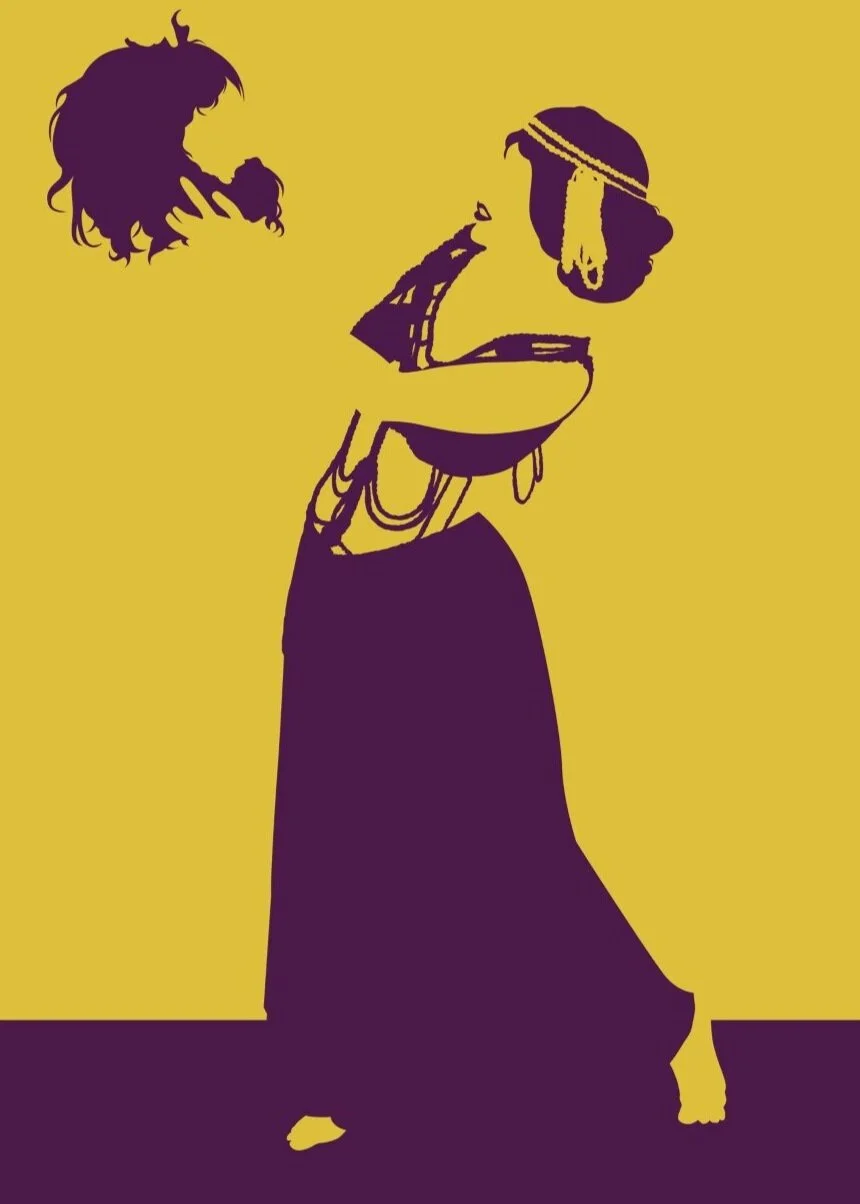Staging Decadence: An invitation
Image: María María Acha-Kutscher, Maud Allan. www.herstorymuseum.
Typical depictions of decadence might call to mind images that look a bit like Thomas Couture’s painting Romains de la décadence (1847), or Sir Lawrence Alma-Tadema’s The Roses of Heliogabalus (1888). Both of these artworks capture the most prominent clichés: orgiastic scenes, indulgent banquets, excessive luxury, and the implication that these features are the hallmarks of an empire at the brink of collapse. Or perhaps you’ve come to this blog as a reader of decadent literature – for instance, as a fan of Joris-Karl Huysmans’s À Rebours (1884), or Rachilde’s Monsieur Vénus (1884). Maybe you’ve come across one of many publications that position decadence as a defining feature of advanced capitalist economies today, plagued by political sclerosis and economic stagnation, or perhaps you’re worried about the framing of arts funding as a form of ‘middle-class decadence’ after a decade of economic austerity and yet more hardship on the horizon as governments struggle with the economic fallout of the coronavirus pandemic. Maybe you were seeking grist to the mill of a view that regards theatre as a decadent art form par excellence – expensive to produce and expensive to consume – or perhaps its status as an art of precarious action marks it out as an ideal forum for exploring the subversive potentialities of decadence as a praxis of creative ruination.
This blog is concerned with all of these resonances, and more, but it is especially concerned with the staging of decadence: playwrights associated with various ‘Schools of Decadence’ in Europe, Russia, the US and Japan in the late-nineteenth and twentieth centuries; cabaret performances in the Weimar Republic; performances of excess in the 1960s and 1970s; queer performance and contemporary drag; punk bodies; and trash aesthetics in live art and performance. It is concerned with decadence’s multiple connotations and meanings as much as what it could mean, but, more than that, it is concerned with encountering decadence ‘in the flesh’. It is also concerned with the material contexts that shape the production and reception of theatre, what decadence can tell us about these contexts, and what the ‘charge’ of decadence can tell us about cultural politics more broadly.
Decadence, derived from the medieval Latin word for ‘decay’, has offered practitioners working across diverse media a valuable framework for exploring identities, desires and relationships to the modern world that transgress normative traditions, conventions and values. As that which relates to ‘decay’, decadence must also refer to some kind of process. As an embodied art of precarious action, this is what makes theatre such a fitting crucible for exploring what decadence is, and why it matters. Theatre past and present offers new ways of understanding the cultural politics of decadence by positioning decadence as a practice.
A decadent take on an idea, appearance or action generally looks for evidence of deviant orientations, uses and velocities. Such a take demands that we unsettle that which appears immutable: for instance, by querying the sanctity of the nuclear family, and the valorisation of work, utility and the forward march of industrial or post-industrial progress. Where familial bonds are prized in an appropriately sanctioned heteronormative and monogamous relationship, decadence recognises desire as a ‘wild thing’ that resists compartmentalisation, and experiments with alternative forms of kinship. Where productivity is intensified in spite, or because, of economic stagnation and crisis, decadence explores what powers and pleasures might lie in the pursuit of alternative intensities, reclaiming forms and combinations of productivity and inertia as sites of playful encounter. Where uses are instrumentalised, decadence revels in the potentialities of ‘queer use’ in which things are used for purposes other than those intended, or by those for whom they were not intended (Ahmed 2019: 26, 34). Where technological or industrial progress reshapes us as much as the environments in which we find ourselves, decadence invites us to take a step back so as to question whether its direction of travel is at all welcome, exploring a spectrum of possibilities and their routes of inheritance. In this, especially, decadence requires that we break things down in order to learn from them. This act of breaking, of disaggregating – of creatively, beautifully ruining – gets right to the heart of decadence. Hence, decadence is not merely concerned with ruination; it might also emerge as a practice of ruination. It is an art that is capable of illuminating, and ruining, that which ruins, and theatre and performance is especially well-equipped to explore and revel in the wreckage.
This blog is intended to address a breadth of examples, issues and preoccupations that relate to theatre, performance and decadence, but all of them, in some form or another, return to the relationship of decadence to cultural politics: why some people and bodies and desires and appearances are valued, but not others; why some forms of creativity, productivity and diligence are considered appropriate, while others are marginalised; and why instrumentality seems so often to be a driver in the establishment of the ‘worthwhile’ and the ‘valuable’, which is an especially pressing line of enquiry in contexts that undermine or marginalise the arts as ‘unproductive’ or ‘valueless’ extravagance. Many of the playwrights and theatre makers considered on this blog offer provocative alternatives to the ‘realism’ of the everyday and the taken-for-granted-ness of ways of thinking and doing by going too far, quite deliberately, in what is being asked of them, resulting in messy, anarchic, and playfully ruinous reimaginings of the malevolent humdrum (sometimes the most insidious forms of oppression and inequality are those that go unseen or unnoticed every day), or by charting creatively ‘regressive’ alternatives to the myths of eternal growth and progress. You will find decadence appearing in multiple guises: in the look of a performance, in forms of enactment and embodiment, in feelings that reside in the flesh. You will find experimentation with decadence on multiple stages: historically, from the fin de siècle to the present moment, but also geographically. Decadence travels, and in the context of theatre and performance it does so as a travelling practice, one that journeys across media, genres, cultures and periods.
This blog is also an invitation. It is an invitation to the reader to consider where and how decadence might be staged, what it can teach us, and what it can tell is about why we value what we value. And it is also, quite literally, an invitation to contribute. If you’re an artist, researcher, philosopher, or a critic, if you run or work at a cultural institution, if you’re coming to this blog as a fan of decadent literature, or contemporary performance, you are invited to contribute. For details on how to do so, just get in touch.
Dr Adam Alston, Goldsmiths (University of London)
Works cited
Ahmed, Sara (2019) What’s the Use? On the Uses of Use, Durham and London: Duke University Press.

